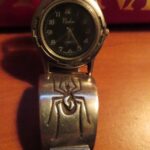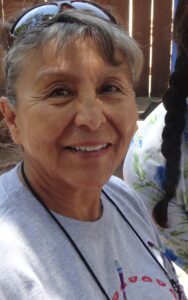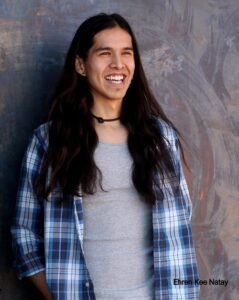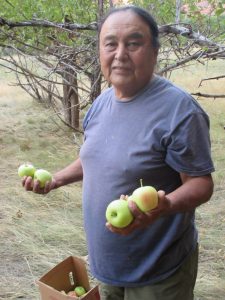We are the weavers, we are the web
We are the flow, we are the ebb
—Shekkinah Mountainwater
She hid herself as quickly as she could. The hulking figure was walking directly towards her and she knew what had happened to so many others of her family in a similar situation–a horrible death. Crouching in the shadows she waited for what was to come next. But in her wildest imagination, she could not have guessed what did come next.
“It’s OK, I’m not going to hurt you. You can come out,” I said quietly as I gently knocked on the window frame where the spider had hidden when she saw me walking towards her.
To tell the truth, I was lonely. Coming from a middle-class family, I was finding it hard to relate to the uber wealthy students at the University of Denver where I attended in 1971. They stepped out of their Lamborghinis with designer jeans that cost more due to the intentional holes in the knees. I stepped down from a used VW bus to get to my clerical work study job at the history department office.
This particular night in my basement apartment I felt especially lonely. When I spied a spider on the wall near the window, I thought, “Maybe here’s someone I can talk with.”
Little did I know how right I was.
As I walked towards the spider, she saw me too and quickly retreated under the window frame, fearing the worst. Many people smash spiders when they are in their home, maybe out of fear of the unfamiliar, unknown—the “other.” With some, their fear gets out of hand and they feel uneasy in any area they believe could harbor spiders or might have a web. Some people scream, cry, have emotional outbursts, experience trouble breathing or go into panic attacks. We’re talking extreme arachnophobia, and in some cases, even a realistic picture or drawing of a spider can trigger intense anxiety.
“It’s OK, I’m not going to hurt you,” I repeated to my little hidden arachnid.
Well, if I haven’t lost you at this point, perhaps you’ll believe what happened next: First one little leg emerged, then another and another until she was fully out on the wall. “Hungry,” came to my mind. I searched the nearly empty college student fridge, brought back yoghurt and put a drop of it on the wall—which the spider moved up to and ate. A few days later, she traveled on.
I traveled on, too, was drafted out of graduate school into the Army during the latter days of the Vietnam War, went back to Denver after my discharge, entered graduate school at the University of Colorado and eventually moved to Santa Fe, New Mexico from Boulder. One day, in 1980 in the Chupadero Valley north of Santa Fe where I was living, I felt I was being watched while showering. Looking up, I noticed a black spider had come out of the plumbing. I wasn’t too concerned as she was busy working on her web and enjoying a bit of steam bath at the same time. This went on for months until spring solstice 1981 when I sadly found her lifeless body belly up on the shower floor. And as I suspected, there was an orange hourglass on that belly. A Black Widow spider.
Spiders kept showing up around me. In 1984 at the Hopi Mesas of Arizona I was helping guide a tour for the Wheelwright Museum of Santa Fe as the new director of public information. Waiting for the tour group to assemble after breakfast one cold and breezy morning, I took a short walk to the edge of the mesa. Here I was 300 feet above the desert floor on a dry wind-swept mesa but from somewhere I heard a small drip of water. I gazed out at the valley below and the sacred San Francisco peaks in the distance. It was a profound moment that I expressed in these words, called “Over the Hill”:
Insistently,
the wind pushed me
over the rock ledge
and down to the lair of Grandmother Spider
Water dripped like
grains of sand,
like time itself into
the pool of time again.
Here, where sky meets
earth,
Man met something
not quite understood.
In the mystery,
in the majesty,
where stones speak
words unutterable,
A breath,
a new beginning,
a step into the unknown.
“You’ve been over the hill,”
He said, his suglassed
eyes narrowing in scope,
wide with knowing.
“Yes,” I said.
“I have.”
As the museum tour progressed, I noticed homes with a black spider painted over doors and later learned about Grandmother Spider who stories say wove the web of Creation for First Man and First Woman. I learned that some Indigenous Americans thought the spider protected against danger from natural phenomena.
In Hindu mythology, the little arachnid represented the weaver of magic and destiny. Egyptians saw her as an attribute of Neith, a creator of the world and to the Romans she was as omen of good luck. But when it came to Christianity, both spider and snake didn’t fare so well, as they represented the Devil ensnaring sinners. No matter the view, it was a lot of responsibility for such a small creature.
Small but powerful. Spider silk is stronger than steel and tougher than Kevlar pound for pound. Their web is one of the most dramatic examples of perfect geometry in the natural world and such a successful invention that it has remained essentially unchanged for 140 million years. Recent research has shown that the webs actually strengthen after they are slightly damaged. According to scientists, spiders are antisocial arachnids who want to be left alone. Maybe so, but the spiders I kept meeting were friendly, even helpful.
In May 1986, I found myself resting upon a pink granite boulder above the Randall Davey Audubon Center in the upper Santa Fe canyon area. I was quiet, enjoying a meditative moment. As I looked down at the trickle of water flowing below, I saw something next to it that looked like a stone, but not quite. Curious, I climbed off the boulder for a closer look and discovered it was a weathered turtle shell. What are the chances of that in this area I wondered to myself. As I approached, spiders on either side of the shell seem to be guarding it, even offering it to me. They withdrew as I got closer. Astonished at what was happening, I accepted the shell as a gift and later it became the receptacle for the pennies I use with the Chinese I Ching system of divination.
Grandmother Spider kept weaving my story web ever larger. Nearly 20 years later in February 1997, I was fortunate to witness the Snake Ceremonies at Hopi Second Mesa. I also visited the home and studio of artist Ross Joseyesva Jr. who had served as a guide for an Institute of Noetic Sciences group I led in the Southwest a number of years before.
I was seeking a new watch band made by a local Southwestern artist, and I stopped in to say hello and see Ross’ jewelry work. After a pleasant catch-up conversation, we went to the studio and looked through his portfolio. As he turned a page, I spotted a design with spider.
“That’s the one,” I exclaimed, and began to relate my spider tales. He listened quietly and then said, “You are a friend of the spider. I’ll put the friendship sign on the design.” It just so happened that Ross’ studio was within sight of a shrine for the Spider Klan. I ordered the watchband without making a deposit or pre-payment.
Weeks went by and the watch band went to the back of my mind as I got busy planning an Earth Walks overnight event at the home and weaving studio of Max Cordova in the Truchas foothills above Chimayo north of Santa Fe. The Cordova studio and residence sits on a spectacular finger of high-country land overlooking the village of Cordova and a wide circle of sky, mountain ranges and the Rio Grande Valley.
It was summer solstice, June 21, 1997 and full moon, an auspicious convergence. Participants included Max and his family, 77-year-old curandera (healer) May Delgado and other elders from the area who dropped by to visit as well as a five-year-old boy named James who was wise beyond his years. And it seemed to me that Grandmother Spider showed up as well.
As the group gathered, little James stood tall atop a green plastic chair facing the immensity of desert and mountains to the west. In his hands, stones were speaking through him to us, this weekend gathering of our Earth Walks vecinos–compadres y comadres, tios y tias–friends and family new and old.
James held a small stone in his young hands. “Now pass this stone from person to person,” James instructed. Stone passed, hearts opened, the breeze blew and the earth turned a bit more in its dance on this our second Earth Walks for people living with HIV, their care givers, friends and family. We camped out on the land, full moon sailing silently over the majestic Truchas peaks, some still white with winter snow, silently standing sentinel above us.
“Just do the weaving and don’t think about it much,” Max advised, when the next day we all tried our hand at his looms, looms that over the years had created an abundance of beautiful tapestries. As I began to run the shuttle, mental distractions and random thoughts cris-crossed my mind. My shuttle got tangled in the threads like a fly in a web, and like the fly, my mind got tangled up too.
“Just keep it simple,” I told myself as I finally extracted the shuttle from the threads. This was a lot like other times in my life, trying to do too much in too little time. It seemed as if Grandmother Spider was telling me to slow down, have some patience and get my conscious mind out of the way of the creation. And I did. At least a little, enough to see some of what Max was talking about.
It didn’t dawn on me until 2017 while writing this story that there was an amazing pattern weaving itself all around me during the Earth Walks, like a spider web of balance and beauty. Just the day before our visit to the weaving studio in Truchas, my spider watch band arrived in the mail from Ross. Fortuitous timing, on a full moon summer solstice. I hadn’t made any payment to Ross. He simply sent it when it was finished in an act of trust and friendship.
That act of trust spiraled back 40 years to the trust a spider at the window and I had one lonely night during graduate school. All my web of relationships with spiders over the years has woven sacred strands of kinship between me and the natural world. I know now without a doubt if I get into a basement of loneliness again, I’ll be sure to have yoghurt on hand and look for one of God’s little eight-legged children.














 Dine guide Daniel Staley with weaver Kathryn Paymala
Dine guide Daniel Staley with weaver Kathryn Paymala





